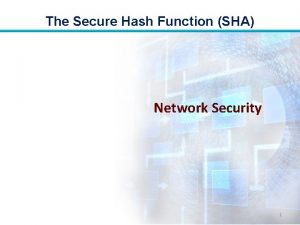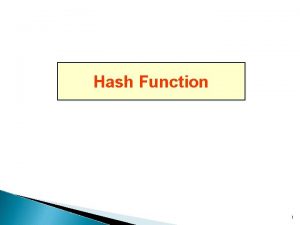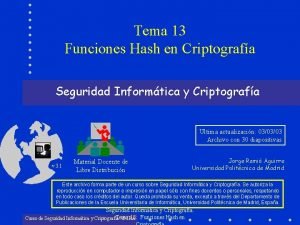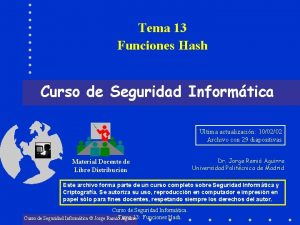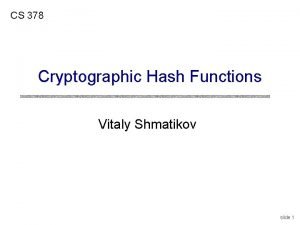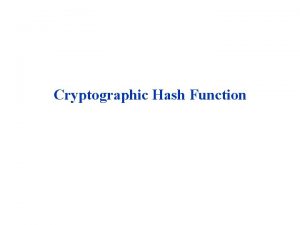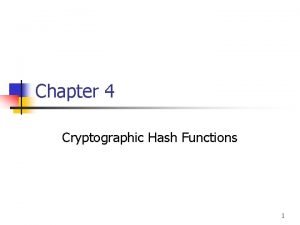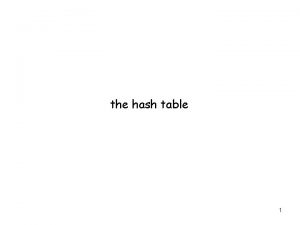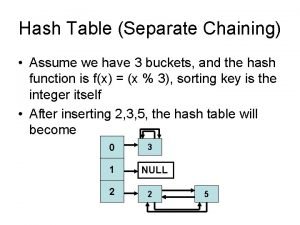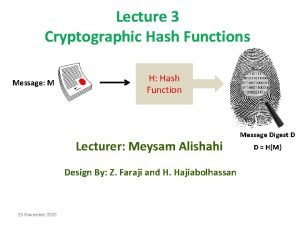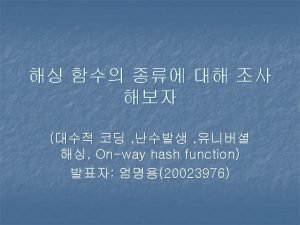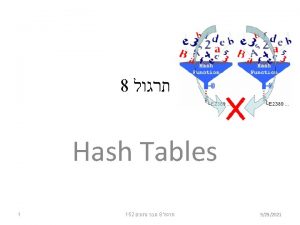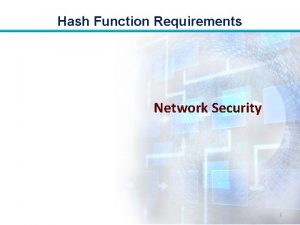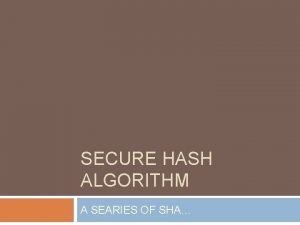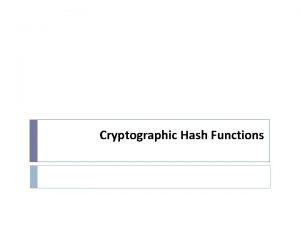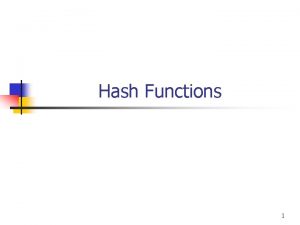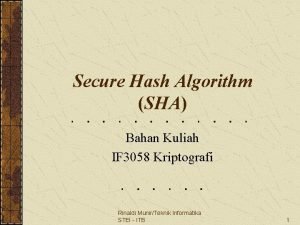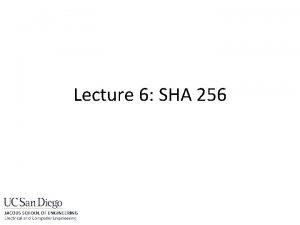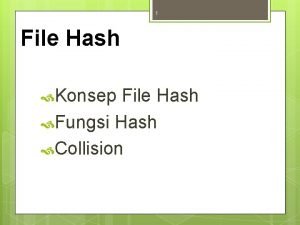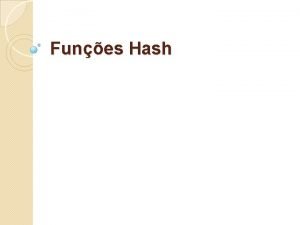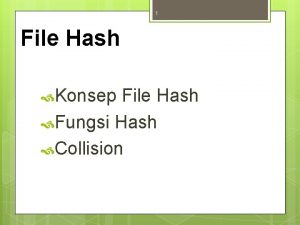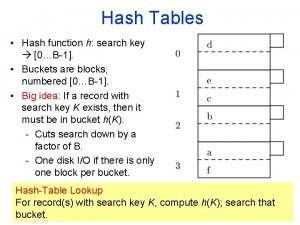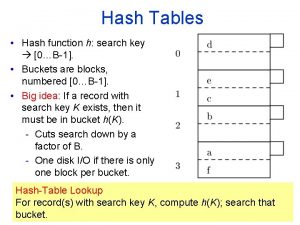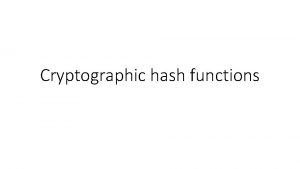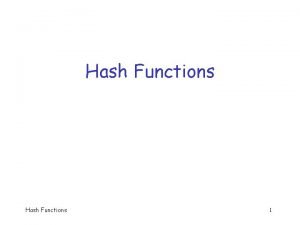The Secure Hash Function SHA Network Security 1
























- Slides: 24

The Secure Hash Function (SHA) Network Security 1

The Secure Hash Function (SHA) Objectives of the Topic • After completing this topic, a student will be able to – explain working of the secure hash algorithm (SHA). 2

The Secure Hash Function (SHA) Figures and material in this topic have been adapted from • “Network Security Essentials : Applications and Standards”, 2014, by William Stallings. 3

The Secure Hash Function (SHA) Secure Hash Algorithm (SHA) • Is the most widely used hash function in recent years. • Developed by the National Institute of Standards and Technology (NIST) • FIPS 180 in 1993. 4

The Secure Hash Function (SHA) • The actual standards document is entitled “Secure Hash Standard. ” • SHA is based on the hash function (Message-Digest) MD 4, and its design closely models MD 4. 5

The Secure Hash Function (SHA) • When weaknesses were discovered in SHA (now known as SHA-0), a revised version was issued as FIPS 180 -1 in 1995 and is referred to as SHA-1. 6

The Secure Hash Function (SHA) • In 2002, NIST produced FIPS 180 -2. • Three new versions of SHA with hash value lengths of 256, 384, and 512 bits known as SHA-256, SHA-384, and SHA-512 were defined. • Collectively, these are known as SHA-2. 7

The Secure Hash Function (SHA) Comparison of SHA Parameters 8

The Secure Hash Function (SHA) • In 2005 NIST announced the intention to phase out approval of SHA-1 and move to a reliance on SHA-2 by 2010. • We focus on SHA-512. 9

The Secure Hash Function (SHA) SHA-512 Logic: • The algorithm takes as input a message with a maximum length of less than 2128 bits and produces as output a 512 -bit message digest. • The input is processed in 1024 -bit blocks. 10

The Secure Hash Function (SHA) Step 1: Append padding bits • Padding is added, even if the message is already of the desired length. No. of Padding bits = [1 1024] • Padding consists of a single 1 bit followed by the necessary number of 0 bits. 11

The Secure Hash Function (SHA) Step 2: Append length • A block of 128 bits is appended to the message. • This block is treated as an unsigned 128 -bit integer and contains the length of the original message (before the padding). 12

The Secure Hash Function (SHA) • Outcome of first two steps yields a message an integer multiple of 1024 bits in length. • Total length of the expanded message is N × 1024 bits as the expanded message is a sequence of 1024 bit blocks M 1, M 2, . . . , MN. 13

The Secure Hash Function (SHA) Message Digest Generation of SHA-512 14

The Secure Hash Function (SHA) 15

The Secure Hash Function (SHA) Step 3: Initialize hash buffer • A 512 -bit buffer is used to hold intermediate and final results of the hash function. • The buffer can be represented as eight 64 -bit registers (a, b, c, d, e, f, g, h). 16

The Secure Hash Function (SHA) • Initialize these registers by taking the first sixty-four bits of the fractional parts of the square roots of the first eight prime numbers. 17

The Secure Hash Function (SHA) Initialization of the registers 18

The Secure Hash Function (SHA) Step 4: Process message in 1024 -bit (128 -word) blocks • The module labeled F consists of 80 rounds. • Each round takes as input the 512 -bit buffer value abcdefgh and updates the contents of the buffer. 19

The Secure Hash Function (SHA) • At input to the first round, the buffer has the value of the intermediate hash value, Hi-1. • Each round t makes use of a 64 -bit value Wt derived from the current 1024 -bit block being processed (Mi). 20

The Secure Hash Function (SHA) • Each round also makes use of an additive constant Kt, where t = 0 … … 79. • The constants eliminate any regularities in the input data. 21

The Secure Hash Function (SHA) • The output of the 80 th round is added to the input to the first round (Hi-1) to produce Hi. 22

The Secure Hash Function (SHA) Processing of a Single 1024 -Bit Block 23

The Secure Hash Function (SHA) Step 5 Output: End • After all N 1024 -bit blocks have been processed, the output from the Nth stage is the 512 -bit message digest. • In 2012, NIST formally published SHA-3. 24
 Sha in network security
Sha in network security Characteristics of secure hash function
Characteristics of secure hash function Tema de hash hash
Tema de hash hash Algoritmo abcde
Algoritmo abcde Privat security
Privat security What is osi security architecture
What is osi security architecture Guide to network security
Guide to network security Wireless security in cryptography
Wireless security in cryptography Electronic mail security in network security
Electronic mail security in network security Security guide to network security fundamentals
Security guide to network security fundamentals Security guide to network security fundamentals
Security guide to network security fundamentals Mid square hashing method
Mid square hashing method Collision resistant hash function
Collision resistant hash function Hash function in cryptography
Hash function in cryptography Cryptographic
Cryptographic Spatial hash grid
Spatial hash grid Hash separate chaining
Hash separate chaining Separate chaining
Separate chaining Hash function for anagrams
Hash function for anagrams Mh to hash
Mh to hash One-way hash function
One-way hash function Secure socket layer and transport layer security
Secure socket layer and transport layer security Secure socket layer and transport layer security
Secure socket layer and transport layer security Secure socket layer and transport layer security
Secure socket layer and transport layer security Secure socket layer and transport layer security
Secure socket layer and transport layer security
